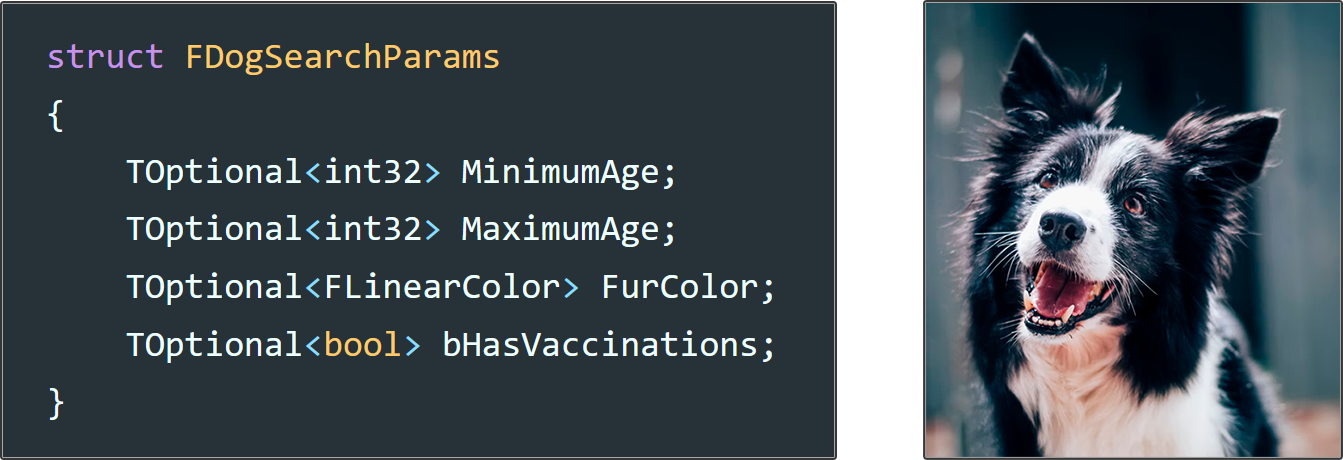Every so often I find a new class or function in Unreal, and I find it so useful that I start using it everywhere. TOptional<T> is one such class.
Doggy Example
Imagine we're making a pet shelter game, where players can search for dogs that they want to rescue and give a good home.
In our example, players can set any number of search parameters of the kind of dog they would like.
Without TOptional<T>
We might start out with a search parameters struct like this:
struct FDogSearchParams
{
// Treat -1 as unset
int32 MinimumAge = -1;
int32 MaximumAge = -1;
// Treat Magenta as unset
FLinearColor FurColor = FLinearColor::Magenta;
// Oh, boolean only has 2 values, what do we use for "unset"?
bool bHasVaccinations = false;
}
In our search code, we could detect whether the player has specified each parameter something like this:
// Has the player has set a minimum age?
if (params.MinimumAge != -1 || params.MaximumAge != -1)
{
// Filter by age
}
// Has the player chosen a color? Treat FLinearColor::Magenta as
// unset, because pink dogs don't exist
if (params.FurColor != FLinearColor::Magenta)
{
// Filter by fur color
}
// Oh true/false could both be valid, now what?
if (params.bHasVaccinations)
{
}
You can see we go from treating -1 as unset, which is pretty sensible. To treating FLinearColor::Magenta as the color being unset, which is kind of weird. To being totally stuck when we try to come up with an "unset" value for a boolean parameter.
With TOptional<T>
What happens if we rewrite the struct above using TOptional<T>?
We can use TOptional<T> for, you guessed it, optional parameters.
struct FDogSearchParams
{
TOptional<int32> MinimumAge;
TOptional<int32> MaximumAge;
TOptional<FLinearColor> FurColor;
TOptional<bool> bHasVaccinations;
}
We no longer need magical values that we treat as unset, we instead have an explicit IsSet() function we can call.
// Has the player has set a minimum age?
if (params.MinimumAge.IsSet() || params.MaximumAge.IsSet())
{
// filter by age ...
}
// Has the player chosen a color?
if (params.FurColor.IsSet())
{
// Filter by fur color
}
if (params.bHasVaccinations.IsSet())
{
// Filter by vaccination state
}
TOptional Usage Overview
Now that we can see how TOptional<T> is useful, what can else can we do with it?
// After creation, Size.IsSet() returns false
TOptional<int32> Size;
// Assignment is standard, and after this, Size.IsSet() returns true
Size = 16;
// Get the current value with GetValue()
UE_LOG(LogTemp, Verbose, TEXT("Size is: %d:"), Size.GetValue());
// == works as you'd expect, and will return false if IsSet() is false
if (Size == 16)
{
// returns true
}
- There is a
checkf(IsSet())insideGetValue(), so if you callGetValue()on an uninitialized value, your game will crash. Get(DefaultValue)is an alternative that if unset, it will return the provided value. e.g.MyDog.IsCute.Get(true)because all dogs are cute unless otherwise specified.
UI Example
A common way I use TOptional<T> is to make it clear when a newly-instantiated widget's internal cached state has never been set, and so its visual should be refreshed the first time its state is set.
That means that when the widget is instantiated, I consider both its cached state and visual state to be undefined.
UCLASS(Abstract)
class UDogStatusPanel : public UUserWidget
{
void SetIsTailWagging(bool bIsTailWagging);
protected:
TOptional<bool> bIsTailWagging;
};
void UDogStatusPanel::SetIsTailWagging(bool bInIsTailWagging)
{
// Only change visual state if we have undefined state
// or if the values differ
if (bIsTailWagging.IsSet()
&& bIsTailWagging == bInIsTailWagging)
{
return;
}
bIsTailWagging = bInIsTailWagging;
// Set up some expensive visual state...
}
